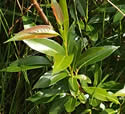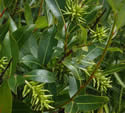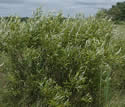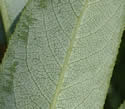Salix serissima (Autumn Willow)
| Also known as: | |
|---|---|
| Genus: | Salix |
| Family: | Salicaceae (Willow) |
| Life cycle: | perennial woody |
| Origin: | native |
| Habitat: | sun; wet; shores, fens, swamps, bogs, floating mats, sedge meadows, peatlands |
| Bloom season: | May - June |
| Plant height: | 3 to 10 feet |
| Wetland Indicator Status: | GP: OBL MW: OBL NCNE: OBL |
| MN county distribution (click map to enlarge): |  |
| National distribution (click map to enlarge): |  |
Pick an image for a larger view. See the glossary for icon descriptions.
Detailed Information
Flower: 

Male and female flowers are on separate plants (dioecious) in spike-like clusters (catkins) at the tips of short branchlets along 1 year old branches, emerging with or just after the leaves. Male catkins are 1 to 2 inches long, the flowers densely packed, each flower with 3 to 9 yellow-tipped stamens that have a few hairs on the lower half of the stamen stalk (filament). Female catkins are 2/3 to 2 inches long, the flowers crowded or somewhat loosely arranged on the spike, bulbous at the base with a long beak, hairless, and on slender stalks 1.2 to 2.4 mm long. At the base of each male and female flower stalk is a yellowish scale-like bract moderately to densely covered with straight or wavy hairs. The bracts drop off as fruit develops.
Leaves and stems: 

![[photo of leaves]](/udata/r9ndp23q/pd3/salix-serissima-7080291-6-t.jpg) Leaves are alternate, 1¾ to 4 inches long, to 1½ inches wide, 2.4 to 6 times as long as wide, lance-oblong to elliptic to narrowly egg-shaped, widest at or below the middle, rounded to somewhat wedge-shaped at the base, with a long taper to a pointed tip. The upper surface is shiny dark green, the lower surface paler, whitish-green to blue-green. Edges are finely toothed with a tiny gland at the tip of each tooth; a few glands are usually also near the tip of the leaf stalk where it meets the blade.
Leaves are alternate, 1¾ to 4 inches long, to 1½ inches wide, 2.4 to 6 times as long as wide, lance-oblong to elliptic to narrowly egg-shaped, widest at or below the middle, rounded to somewhat wedge-shaped at the base, with a long taper to a pointed tip. The upper surface is shiny dark green, the lower surface paler, whitish-green to blue-green. Edges are finely toothed with a tiny gland at the tip of each tooth; a few glands are usually also near the tip of the leaf stalk where it meets the blade.
![[photo of orange-brown twid]](/udata/r9ndp23q/pd3/salix-serissima-7080291-14-t.jpg) Leaf-like appendages at the base of the leaf stalk (stipules) are absent or obscure. New leaves are reddish or yellowish-green, shiny and hairless. A fine network of veins is visible on the lower leaf surface. New branchlets are yellowish-green and hairless, becoming orange-brown to red-brown and glossy the second year.
Leaf-like appendages at the base of the leaf stalk (stipules) are absent or obscure. New leaves are reddish or yellowish-green, shiny and hairless. A fine network of veins is visible on the lower leaf surface. New branchlets are yellowish-green and hairless, becoming orange-brown to red-brown and glossy the second year.
![[photo of lower stems]](/udata/r9ndp23q/pd3/salix-serissima-7080291-18-t.jpg) Stems are multiple from the base, have smooth to slightly rough gray-brown bark, and can reach 1½ inches diameter.
Stems are multiple from the base, have smooth to slightly rough gray-brown bark, and can reach 1½ inches diameter.
Fruit: 
![[photo of maturing fruit]](/udata/r9ndp23q/pd3/salix-serissima-7080291-3-t.jpg) The spike elongates some as fruit matures, the fruit becoming more loosely arranged than the flowers. Fruit is a capsule 7 to 11 mm long, yellowish when mature, hairless, narrowly pear-shaped, inflated at the base with a long beak. The capsule splits into two halves when mature, releasing the cottony seed. Maturity isn't reached until late summer into fall.
The spike elongates some as fruit matures, the fruit becoming more loosely arranged than the flowers. Fruit is a capsule 7 to 11 mm long, yellowish when mature, hairless, narrowly pear-shaped, inflated at the base with a long beak. The capsule splits into two halves when mature, releasing the cottony seed. Maturity isn't reached until late summer into fall.
Notes:
There are over 20 species of Willows in Minnesota; Autumn Willow is one of several common species and is a medium to large, multi-stemmed shrub that can reach a height of 10 feet but is usually not more than 6. It is usually found in open swamps, fens, wet meadows and bogs, often in calcareous or peaty soils. Unlike many other willows, it reproduces only by seed and does not form large stands.
Autumn Willow is recognized by the shiny, toothed leaves up to 4 inches long, many of which have a long, slender, tail-like tip; leaf-stalks usually have small glands at the tip near the blade; hairless capsules 5 to 7 mm long on stalks up to 2 mm long; male flowers have 2 stamens. Both male and female flowers emerge with the leaves and are subtended by a yellowish to greenish bract with sparse, wavy hairs. Stipules are persistent, small and minutely toothed, with a gland at each tooth tip. New leaves commonly have at least some rust-colored hairs but they do not persist. The large bud scales are pretty distinctive. Be sure to inspect several leaves before determining glands are absent.
Autumn Willow most closely resembles Shining Willow (Salix lucida), which also has shiny leaves and glands at the tip of the leaf stalk, but is a larger shrub, usually over 6 feet, stipules are usually present, new leaves are hairy, leaf tips have a longer taper to a point, leaf underside is green and only somewhat paler than the upper surface, male flowers have 2 stamens, and it usually releases seed by the end of June, where Autumn Willow fruit can persist into October. The only other Willows in Minnesota with shiny leaves and glands on the leaf stalk are Bay Willow (Salix pentandra) and Crack Willow (Salix fragilis), both non-native trees with longer, more slender catkins. Bay Willow is mostly seen in cultivation, only occasionally in the wild and has proportionately broader leaves with a shorter taper to the tip; Crack Willow has narrower, stiff leaves.
Native Plant Nurseries, Restoration and Landscaping Services ↓
More photos
 Autumn Willow plant
Autumn Willow plant Autumn Willow plant
Autumn Willow plant Autumn Willow plant
Autumn Willow plant Autumn Willow plants
Autumn Willow plants Autumn Willow sedge meadow habitat
Autumn Willow sedge meadow habitat new leaves are reddish or yellowish
new leaves are reddish or yellowish leaf underside is paler blue-green to whitish-green
leaf underside is paler blue-green to whitish-green leaf scan
leaf scan comparison of Salix serissima and S. lucida leaves
comparison of Salix serissima and S. lucida leaves
Photos by K. Chayka and Peter M. Dziuk taken in Marshall County.
Comments
Have you seen this plant in Minnesota, or have any other comments about it?
on: 2019-06-17 21:02:05
In a fen in Zim. Its leaves were being eaten by the larvae of a species of sawfly (Nematus calais).
on: 2020-06-30 00:31:40
I have two volunteer willow saplings in my garden (grew in a neglected gardening tub so lots of water) only around 2 years old. It hasn't bloomed yet so I can't tell yet. The reddish stalks and leaf shape and fineness of tooth and gloss are most similar to autumn willow. The stem though has a dusty grey bloom. New leaves are not reddish. It looks most like autumn willow or a hybrid (there's a weeping willow down the road.) I transplanted one and left a smaller one in situ.






